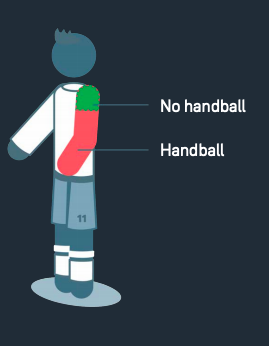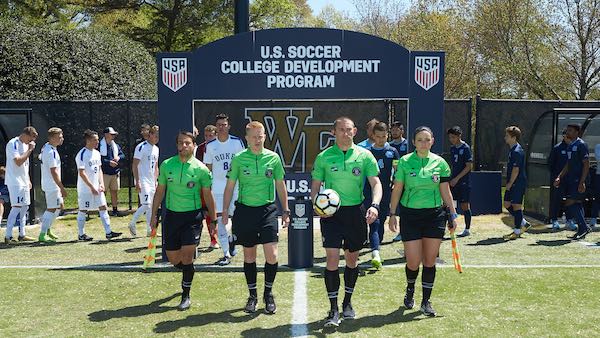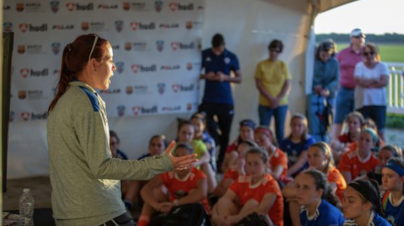Certified Referee Breaks Down the new IFAB Laws of the Game

By Adam Schwager
SoccerWire Contributor and Certified Referee
As states start to ease off coronavirus restrictions, many youth leagues are finally getting back on the field to start their 2020-21 seasons. With most teams having not played organized games since the new International Football Association Board (IFAB) Laws of the Game changes came into effect on July 1, here’s a rundown of the changes that will come into effect in your upcoming season.
Handball
The most vital change to the laws, for the second year in a row, comes in IFAB clarifying what is and what isn’t a handball. For years, IFAB had left lots of discretion for referees in handball calls, but as VAR has become a larger part of the professional game, IFAB has started adding clarifications to make sure that handballs are called the same way across all leagues and levels.
For the 2019-20 season, one of the major changes that was implemented was saying that “it is a [handball] offence if a player gains possession/control of the ball after it has touched their arm/hand and then creates a goal scoring opportunity.”
This new law change led to controversial calls at the pro level, as referees were unclear whether an accidental handball in the build-up to a goal qualified as an automatic handball offense. To clarify some of the confusion, IFAB included two points of emphasis to “clarify the ‘spirit’ (intention) of the Law.”
The Law now reads “if the ball touches an attacking player’s hand/arm and then goes to another attacker and a goal or scoring opportunity occurs immediately, this is a handball offence,” and added “it is not an offence if, after an accidental handball, the ball travels some distance or there are several passes or there is a notable ‘time interval’ between the ‘handball’ and the goal or scoring opportunity.”
This clarification should have massive implications for leagues using VAR, but will also be a point of emphasis for referees in lower levels of competition.
 IFAB also clarified which part of a player’s arm the ball has to hit to qualify for a handball offense. The law now reads “for the purposes of determining handball offences, the upper boundary of the arm is in line with the bottom of the armpit.” This is probably the largest change for lower levels of play, as a player’s shoulder is now no longer considered a part of their arm. This change will probably lead to less handball offenses being called overall, as referees will most likely not be calling many handballs unless the ball hits below the elbow.
IFAB also clarified which part of a player’s arm the ball has to hit to qualify for a handball offense. The law now reads “for the purposes of determining handball offences, the upper boundary of the arm is in line with the bottom of the armpit.” This is probably the largest change for lower levels of play, as a player’s shoulder is now no longer considered a part of their arm. This change will probably lead to less handball offenses being called overall, as referees will most likely not be calling many handballs unless the ball hits below the elbow.
Offside
IFAB made a minor change to the offside law when it comes to deliberate handballs. Even if in an offside position, a player can not be called for an offside offense if a player on the opposing team deliberately misplayed the ball to the attacking player.
Under the previous iteration of the law, it was unclear whether or not a deliberate handball from the defending player counted as a deliberate misplay for the purposes of offside. Now, the law is clear. If a defending player misplays a ball with a deliberate handball to a player in an offside position, the attacking player gained no clear advantage and will be declared onside.
The referee will still have discretion to call the deliberate handball if there is no advantage for the attacking team, but in most cases, referees will give the advantage to the attacking player and can not call an offside offense under these circumstances.
Kicks from the Mark
In the rare event your game ends with kicks from the mark (KFTM), IFAB has made a couple of major law changes to the process.
While players who receive a red card during the match will still not be permitted to participate in KFTM, yellow cards will no longer carry over from the main match into the tiebreaker. This is particularly important for goalkeepers, as previously an encroachment offense on a goalkeeper with a yellow card would automatically result in a second yellow and a dismissal for the keeper. The player will have recorded two yellows for purposes of league disciplinary action in leagues that have automatic suspensions for accumulating cards, but the player will not be sent off from the tiebreaker.
Two new law changes have also made it harder for a keeper to receive a yellow in KFTM. Instead of receiving a yellow on their first offense for encroachment, the keeper will receive a warning and be cautioned for their second offense. Combined with the law changes outlined in the paragraph above, keepers will have had to accumulate three offenses in KFTM to get sent off.
In addition, if the keeper and the kicker both commit offenses at the same time, the attempt will be recorded as a save and only the kicker will be cautioned. Under the previous law, the attempt was retaken regardless of the result and both players were cautioned. IFAB found that in the rare instances when both players committed offenses on the same penalty kick, the keeper’s offense was almost always in response to the striker illegally feinting, therefore only the kicker should be penalized for the offense. If this happens during an in-game penalty kick, the defending team is awarded with an indirect free kick from the penalty mark.
 Goalkeepers also received one more change for penalty kicks in their favor, as a goalkeeper offense no longer results in an automatic retake. Previously, any encroachment on the goalkeeper automatically resulted in a yellow card for the keeper and a retake if the attempt was saved or missed. Under the law change, a retake will only occur if the keeper makes a save or if the kicker was “clearly impacted” by the keeper’s offense.
Goalkeepers also received one more change for penalty kicks in their favor, as a goalkeeper offense no longer results in an automatic retake. Previously, any encroachment on the goalkeeper automatically resulted in a yellow card for the keeper and a retake if the attempt was saved or missed. Under the law change, a retake will only occur if the keeper makes a save or if the kicker was “clearly impacted” by the keeper’s offense.
If a keeper commits an offense but the kicker airmails the ball or hits the post, no retake will be granted, and the keeper will receive a warning (or a yellow card if they had already been warned).
These law changes are especially important in the aftermath of the 2019 Women’s World Cup, where VAR created a massive disadvantage for goalkeepers in key moments of the tournament. While keepers still have to be incredibly careful about their positioning on penalty kick attempts, their missteps will now be a lot less costly to themselves and their teams.
Keeper’s Illegal Second Touch
While goalkeepers received a lot of help on penalty kicks from the updated laws, they also got hurt with another change. Previously, keepers could not get disciplined for an illegal second touch within their penalty area. The most common occurrence of this law happens when a keeper misplays a goal kick, or any form of free kick, and touches the ball a second time (with any body part including their hands) before another player has touched the ball. Now, if the result of the infraction ends up denying the opposing team a promising attack (yellow) or a clear goal scoring opportunity (red), the keeper must be sanctioned with the proper card.
Card Changes on Stopping a Promising Attack Offenses
IFAB made an important change to stopping a promising attack (SPA) offenses (often known as a tactical foul) when the non-offending team decides to take a ‘quick’ free kick to keep their advantage alive. Currently, if a team decides to take a ‘quick’ free kick after an offense that would result in a denying an obvious goal scoring opportunity (DOGSO) red card, that card is downgraded to a yellow card and issued at the next stoppage of play.
For the sake of consistency, IFAB has now updated the laws so that when a team decides to take a ‘quick’ free kick after an offense that would result in a SPA yellow card, the card will not be issued. If the disadvantaged team decides to not take a quick restart, referees will stop play while the yellow card is being issued and the fouled team will then have a normal free kick.
Not Respecting Distance on a Dropped Ball
The last rule change that affects players also directly results from a 2019-20 rule change to dropped ball procedures. In 2019, contested dropped balls were removed from the game. Any stoppage that requires a dropped ball will be given to the team last in possession of the ball at the position of the last touch, with all other players required to give their distance as they would during a free kick, corner kick or throw-in.
However, IFAB had not updated their disciplinary law to allow for referees to give a yellow card to players who failed to respect the required distance on a dropped ball restart. IFAB fixed their error, and now players can be cautioned for failing to respect the required distance on a dropped ball in the same manner as that of a player failing to respect distance on any other restart. While this is certainly a small change, it is one that could have the widest reaching effects, as dropped ball restarts happen quite often at every level of play.
Conclusion
While some of these changes might seem very minor, you’re likely to be affected by one or more of these new laws in every game you play. Both players and coaches should be aware of these new changes, as all leagues and tournaments are now required to use these laws.
SOCCERWIRE MARKETPLACE
- Wanted Licensed Youth Soccer Coach
- Join Official Elite Summer Soccer Camps with Europe’s Top Pro Clubs!
- The St. James FC Travel Staff Coach - North (Loudoun) & South (Fairfax)
- The St. James FC Girls Academy (GA) Head Coach - 2 teams
- The St James FC Boys Travel Tryouts
- OFFICIAL BAYERN MUNICH SUMMER CAMPS U.S.
- JOIN THE ALLIANCE!
- OFFICIAL FC BARCELONA CAMPS U.S.
- The Cup San Diego - Hosted by Legends FC
- Players Wanted - Undergraduate or Post-graduate


















